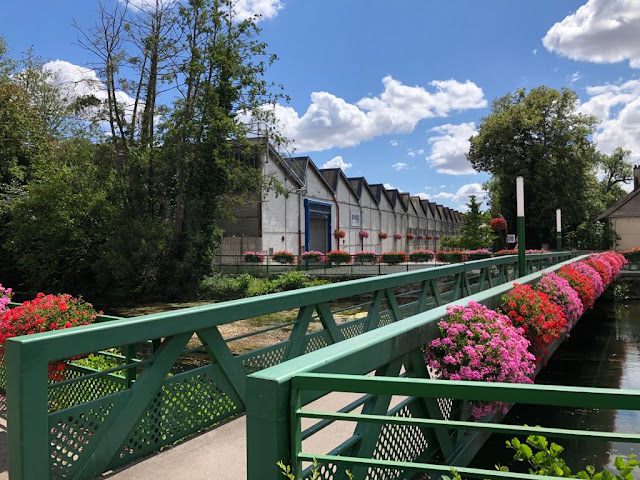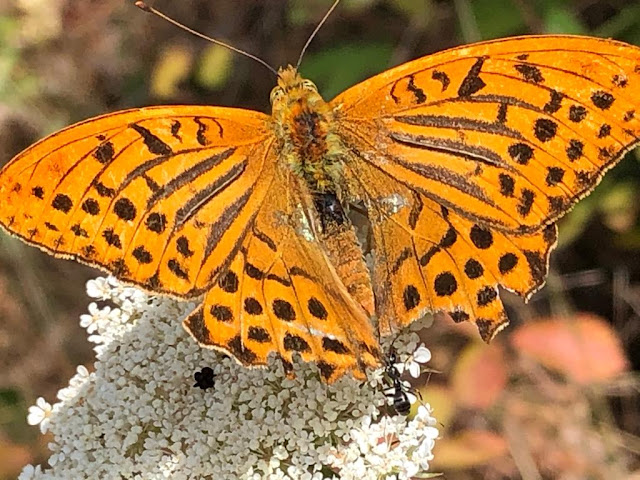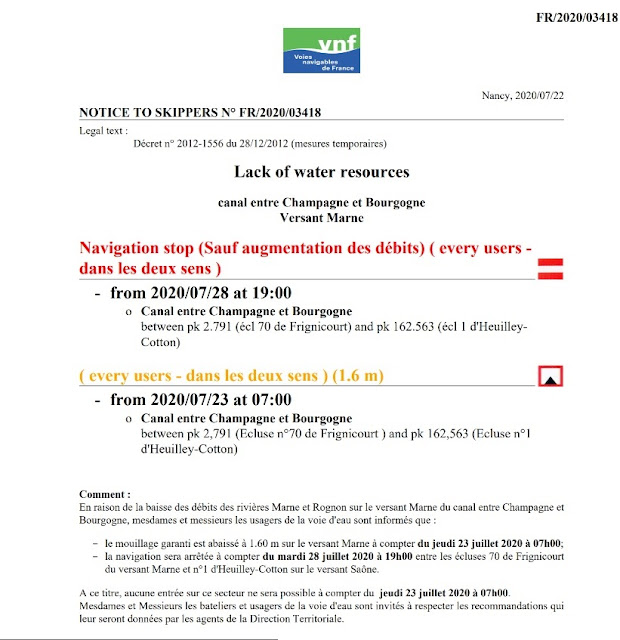Soon after going down the lock there is a sharp bend and a little way further on is a twisty pole. The pole is for use when coming up the lock but because it is quite a way from the lock which is no longer in sight behind, the instant reaction is that it’s the twisty pole for the next lock. Like us, these guys must have twisted it by mistake which meant the lock got itself ready for a boat to come up. Once I was convinced another boat hadn’t set the lock and was coming up, we quickly got dressed, turned the boat around on the spot and went up the lock. The lock is right next to an aqueduct over the River Saulx which, for a reason unbeknownst to us, had a string of bollards along the edge, so we immediately stopped for breakfast before setting off for the day.
 |
| Breakfast on the aqueduct |
 |
| Look at the bollards on the aqueduct – normally they’re like hens’ teeth |
 |
| Early morning mist whilst having pre-breakfast drinks |
After a mile or so we were back at the junction in Vitry; this time we were going to turn left and venture onto the Canal de la Marne au Rhin for the first time, rather than turning right onto the Canal entre Champagne et Bourgogne.
 |
| Turning left at Vitry-le-François |
The canal is 313km long and runs due east to join the River Rhine in Strasbourg which is where we had hoped to get to at the earlier this year but confinement hit. It was opened in 1853 and takes small commercials, or péniches, 39 metres long by just over 5 metres wide. It is regarded as two canals, the Ouest and the Est, divided by a short section of the Moselle in Toul, south of Nancy and Metz.
The locks operate differently depending on where you are on the canal. The locks on the section we would travel on are set in motion by sensors registering that a boat is approaching the lock.
 |
| Waterside sensors |
Once inside the lock one of us gets on the roof to pull up a rod that starts the remainder of the lock operation.
 |
| Karen lifting the operating rod at the first lock |
Like all the other canals we’ve been on over here, every lock seems to have a lock cottage but unlike the other canals, none of the cottages had information plates over their front doors.
 |
| The style of the lock cottages on la Marne au Rhin |
Each lock has a Nissen style hut where éclusiers have access to controls to override the automatic lock operations. There is a limited amount of information on plaques on these huts such as lock number and name but nothing like the lock cottage plates which often include the names of the next lock in each direction and the distances to them.
 |
| Nissen operations hut for éclusiers |
An éclusier was waiting for us in his car at the second lock. He was making sure we knew the canal was closed after the first 30km. We assured him we were turning around before then and he then said that in a day or two it will close 10km sooner which is at the point we were planning on turning anyway.
He got back into his car to make a phone call and we set
the lock going. Only one gate closed
which was the first time we have seen this happen. Fortunately, the éclusier was still on the phone in his
car at the lock so I attracted his attention and he popped into
the Nissen hut to sort things out.
 |
| A first for us – one gate refusing to close |
As soon as we were on this new canal, we could feel it was different. It’s not always easy to explain why the character of one canal is different to another. A lot of it may be to do with our own excitement of exploring somewhere new. Many canals in Europe have had their towpaths converted to cycle routes which, in touristy areas, make a cycling holiday very attractive to some people. The previous canal, although extremely rural always seemed to have some activity going on, whether a group of people cycling down to their next stop for the night or walkers out enjoying the scenery and peace of the countryside.
This latest canal has no such cycle route and the towpath is just a grassy track used by VNF vehicles. This meant we saw no one other than éclusiers and a couple of people at lock cottages all day. The canal wasn’t too weedy and in most parts there was a clear channel along the middle. Tall plane trees lined one or both banks most of the way and every so often we caught glimpses across the arable plain of vineyards on the hills beyond.
 |
| A straight section at the start of the canal |
After the first four locks we arrived at Bignicourt-sur-Saulx where we planned on having lunch and then moving on further in the afternoon.
 |
| Moored at Bignicourt-sur-Saulx |
We were moored under tall trees and it was obviously going to be shady all afternoon and evening, so we decided to stay put and go for a walk instead. The village seemed to be even quieter than usual which made the reading of the WWI information boards somewhat eerie. Like many of the villages in the Marne area this one had been badly damaged in the war, and many villagers lost their lives. One harrowing account explains how 14 women and children were found dead in one cellar. Another account highlights the hand to hand combat that took place as the French tried to stop the German army from crossing the canal.
A convenient bench at one end of the main street gave us a good place to rest in the shade and we joked that we would probably have to stay there all day if we played the game of, ‘Not moving unless a car comes past’. A car did come but stopped at the house in front of us, a jolly lady got out, posted something in a letterbox and then turned the car around to go back the way she had come, so technically not passing us.
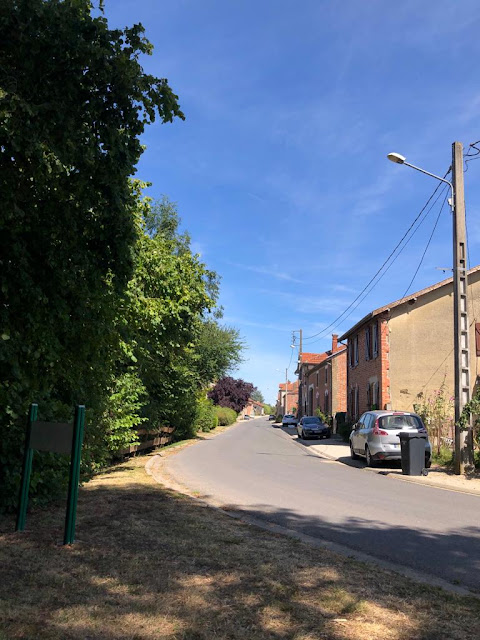 |
| Sitting on the bench looking down the main street |
Next to the bench was a sign indicating that the village had won some sort of floral display competition. It never ceases to amaze us the number of UK and French villages and towns that have won or been runners up for one flower award or another – how many awards are there?
 |
| Settled in for the evening |
On Wednesday we travelled 11 miles up five locks.
Not only did we have shade all afternoon and evening at our mooring in Bignicourt-sur-Saulx, we were fortunate that we had shade on Thursday morning too. We had thought of cruising further up to Pargny-sur-Saulx but looking at the satellite pictures it looked like the mooring was probably in full sun all day. We changed our mind about cruising and decided to walk the 3½ miles to Pargny instead.
When we cruised up to Bignicourt yesterday, we had noticed
a hundred metres or so before each lock stood a precast concrete post. We saw them close up during our walk and could
see they had the words, ‘Limite de stationnement’ stamped on them. They were indicating that péniches couldn’t
be moored between that point and the lock.
These would have been used when there was far more freight traffic than
there is nowadays.
 |
| Limit of mooring |
We also came across the only distance stone we have seen on this canal. It was a bit of an anomaly, not because it was on its side, but because it was showing the distance to Brusson which is a tiny village halfway back to Vitry. Normally the distances are shown to both ends of a canal or at least to the next major town.
 |
| Lone distance stone |
When we arrived at the port in Pargny-sur-Saulx we could see that moored boats would indeed be in full sun all day but as the picnic tables were under some small trees and there were pleasant views, we stopped for our lunch.
 |
| The port at Pargny-sur-Saulx |
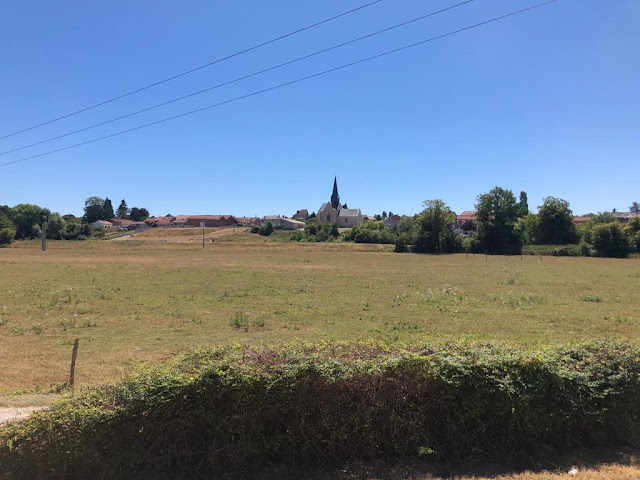 |
| The view across to Pargny-sur-Saulx from the port |
After lunch we walked up to Pargny but found nothing of particular interest to us. Like the village we visited yesterday, there were information boards about the decimation that occurred during WWI and also first-hand accounts of the horrors of war written by local people such as a primary school teacher.
 |
| The mairie |
On the way back we stopped for a relaxing break by the river Saulx. This is the river that joins the Marne just after it goes under the aqueduct we moored on for breakfast yesterday.
 |
| Relaxing in the Saulx |
On the walk back to the boat we popped into the village of Ètrepy as it wasn’t far from the canal. This had a stream running through it and we immediately thought that it would be a good place to find a lavoir. The stream turned out to be a millstream diverted off the Saulx and we soon found the mill but sadly it was abandoned, and the waterwheel had been removed.
 |
| Old watermill in Étrepy |
The village was just after the mill and was deserted apart from an old man sitting in a chair outside a window of his house. He was friendly as we walked past, and we then noticed his wife was sitting at the window too but inside. The mad English couple with a dog walking around their village must have made their day as it didn’t look like much else happened there 😉
 |
| Étrepy (the old couple just out of shot to right as I felt it would be rude to include them) |
The building to the left caught our eye as it looked very lavoir-esque but seemed rather large for the number of houses. It was indeed a lavoir, complete with a drinking fountain outside. The basins were dry, but it shows that there must have been a larger population when it was built compared with nowadays.
 |
| Fountain |
 |
| The dry washbasins |
When we got back to Bignicourt-sur-Saulx we crossed the canal and could just see the boat but were relieved to see it was still in the shade.
We didn’t cruise on Thursday but will be heading back towards Vitry-le-François on Friday.















